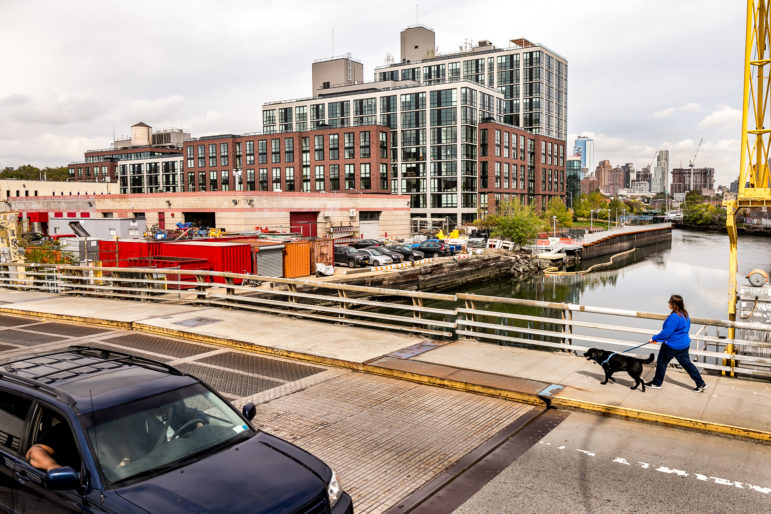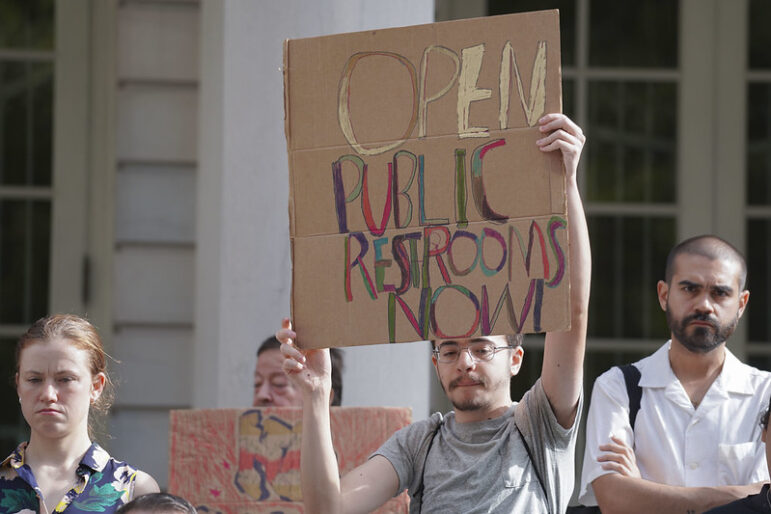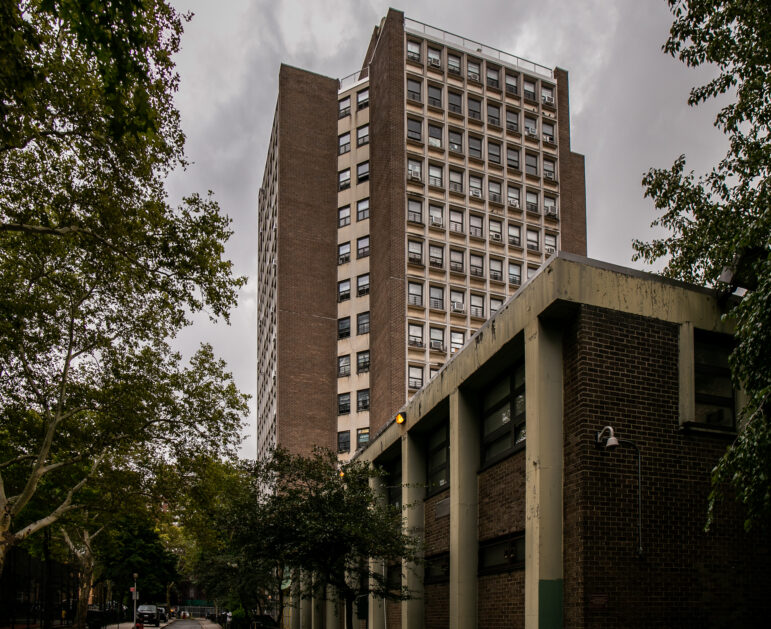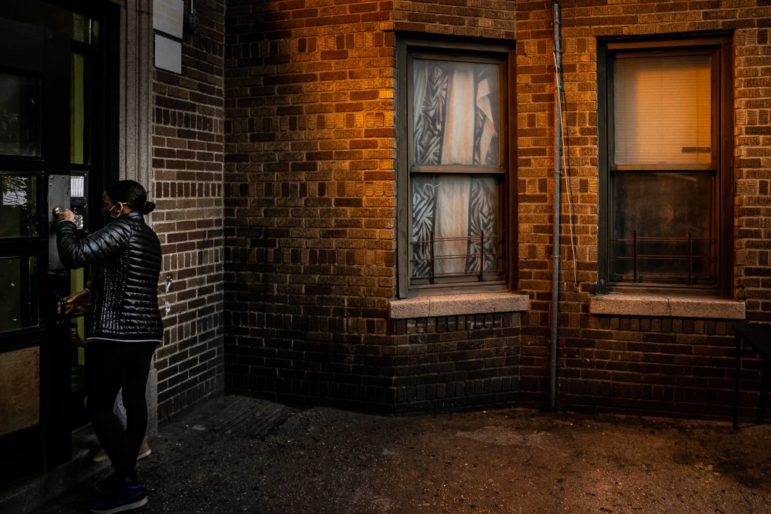
Adi Talwar
The view from the 3rd Street bridge over the Gowanus Canal, where residential and industrial uses already mix—although it is unclear how long that will last.
New Yorkers today are particularly sensitive to the consequences of losing industrial land. A decade of Bloomberg-era rezonings that rapidly reduced the share of city land zoned for industry, as well as a swell of research connecting the decline of manufacturing to wealth inequality, has lead advocates to place unprecedented pressure on the de Blasio administration to protect the city’s remaining manufacturing districts.
While the administration has embraced the call for supporting industry, that aim is often in conflict with the administration’s efforts to rezone neighborhoods to encourage housing development. A proposed rezoning of the Bronx’s Jerome Avenue, for instance, has sparked resistance from community group seeking to preserve the area’s auto-industries.
Nowhere are these concerns more palpable than in Gowanus, where the Department of City Planning is about to launch a community planning process that could lead to a potential rezoning of the neighborhood. Gowanus, named for the canal that was once Brooklyn’s primary industrial artery, has long waged an internal debate about whether—and how—to preserve industrial elements in the face of increasingly intense real estate pressure.
Much of this debate was spurred by Bloomberg-era initiatives: Under that administration, the canal south of Third Street received the protected status of an “Industrial Business Zone.” In some parts north of Third, however, Bloomberg proposed rezoning the area from a manufacturing district to an “MX” or mixed-use district as he had already done in Williamsburg and Long Island City. The “MX” designation would have allowed residential uses alongside commercial and manufacturing uses for the first time. The administration dropped the proposal, however, after the federal government designated the canal a Superfund site—to the relief of some stakeholders, who feared a loss of manufacturing space and an influx of market-rate housing.
In 2013, Councilman Brad Lander launched a community planning process called “Bridging Gowanus” to determine principles to guide a possible future rezoning. During that process, facilitated by the Pratt Center for Community Development, organizers identified the community’s strong interest in sustaining the neighborhood’s mixed-use quality. The Bridging Gowanus final report suggests a number of strategies to strengthen the neighborhood’s industrial base, such as modifying the regulations of the existing Industrial Business Zone to protect industrial uses by restricting the development of hotels, self-storage facilities and large office buildings in the zone.
The report also notes that MX zones are often mixed-use in name only, as developers can fetch higher rents by going completely residential. The Pratt Center found that as of 2014, all neighborhoods that had been rezoned as “MX” or a similar designation had collectively lost 41 percent of their industrial space.
The Bridging Gowanus report calls for the creation of a new zoning designation that it calls “mandatory mixed-use.” Instead of allowing industrial and residential uses side by side, this designation would require that mix, obliging developers to provide a specific amount of industrial space for every square foot of residential space. Both the restrictions and the mandatory mixed-use recommendations mirror proposals put forward by the Pratt Center, which Lander once ran, in prior papers.
“The existing MX districts are essentially a total failure…I’d call them a transition zone,” says Lander, explaining that the mixed-use designation has helped to transform industrial areas into more residential ones. “It’s a pretty fundamental difference to be pushing for something that will require that mix of uses.”
Lander and other advocates of Bridging Gowanus say the new zoning will ensure space for manufacturers and other types of artists and artisans, who are currently at risk of losing land to more lucrative projects like hotels, or to private rezonings of specific lots, like the one that produced the recently completed Lightstone Group residential complex.
“It is encouraging to see a plan that includes the concept of mandatory mixed-use zoning that may include light manufacturing, arts production and affordable artist housing. This approach could provide much needed stability to the industrial and cultural communities in Gowanus, where, we believe, creative working and living can not only coexist, but be mutually reinforcing,” wrote Benjamin Margolis, a consultant working in the Gowanus, in a comment on the Bridging Gowanus Final Report. He acknowledged to City Limits that many details of how the policy would work, and where exactly it would applied, are still to be discussed.
Local activist Katia Kelly, however, is deeply skeptical of a rezoning, and does not trust that the city will be able to come up with an effective policy in time to truly ensure the preservation of industrial space.
“Right now City planning has no tool to do what [Lander] is proposing,” Kelly says. She believes the area already has a smart mix of uses and has “heeled itself and continues to heel itself without a rezoning” but that the prospect of adding a residential component to the area has only exacerbated real-estate pressure by causing multiple property flips in recent years.
Some industry advocates say that while the idea of a mandatory mixed-use district might work well for certain types of companies—high-tech bio-labs, or glass blowers, for instance—it would not sustain more noxious forms of industry that cannot afford the same level of rents, and could not coexist easily with housing.
“Iron shops, sheet meddle factors…incorporating residential above that type of use, it wouldn’t work. It wouldn’t make sense,” says Paul Basile, president of the industry advocacy group Gowanus Alliance, explaining that these “old school” industries are noisier, dustier, and necessitate the coming and going of shipping trucks. They are also, he says, a source of needed blue-collar jobs.
The Bridging Gowanus final report does recognize the compatibility issue. It says the industries appropriate for the zone include “makers” including light manufacturers, artists and artisans, and nonprofit organizations. It then notes that some forms of light manufacturing match poorly with apartments. In addition to recommending that new construction incorporate various design elements like sound buffers to allow harmony between residents and industrial businesses, the report also suggests the creation of a “Transfer of Development Rights District.” Say a developer wanted to construct a residential building without industrial space; they could pay a property owner within the district to expand industrial space on their own property.
Basile, however, says that while a district could help, some heavier uses will still not coexist easily with residents even within the same district. And, one might add, a district also wouldn’t address the economic issue: that advanced manufacturing can fetch higher rents than heavier, more traditional industries.
Basile says any loss of industrial land north of Third Street must be compensated through an increase in industrial space within the Industrial Business Zone—and Lander notes that increasing industrial density in the Industrial Business Zone is also one of Bridging Gowanus’s goals.
Devil in the details
If the Department of City Planning decides there is a need for a mandatory mixed-use zoning district, it will have to determine many aspects of the new policy. One of the challenges of crafting such a zone will be determining a ratio between maker and residential uses. That ratio must reflect the reality that developers will use housing units to cross-subsidize the less-profitable manufacturing spaces.
To achieve the best returns, developers will naturally advocate for a low ratio of maker uses to residential uses, and they could always threaten to bail if the city sets that ratio too high. To translate that into zoning parlance: Developers will ask for a large Floor Area Ratio (FAR)—the amount of floor area allowed for the buildings, measured against the size of the lot—in order to build many apartments to compensate for the lower rents from the industrial spaces.
“We will certainly make it clear, in terms of the FAR [we need] to yield various extents of maker spaces and affordability,” say Ethan Geto, a representative for Property Markets Group, a real-estate company with a specialty in luxury apartments that has recently bought up significant chunks of property along the Gowanus Canal. While PMG has already offered to include maker spaces in future developments, the company hopes the city will be reasonable when deciding an appropriate ratio of maker spaces and affordable-housing units to market-rate units, especially considering the significant costs to PMG of environmental cleanup along the canal.
“At the end of the day, the zoning will be determined through the [Uniform Land Use Review Procedure] process and the developers will have to conform to that zoning. If they feel the zoning does not sufficiently [support] these properties, then they’re not going to get developed,” Geto adds.
Adam Friedman, current director of the Pratt Center, says that the city must commission an analysis of the Gowanus market to determine an appropriate ratio. He notes that earlier this year, the city employed some creative zoning in Williamsburg to try to encourage industrial retention in a single, mixed commercial and industrial building, though he believes the city should have demanded a greater percentage of required industrial space.
Lander agrees that determining an appropriate ratio will require a city-commissioned assessment that draws on hard data as well as interviews with local property owners.
“I’m sure the developers will run their own numbers, I’m sure Pratt will run their own numbers, but the city needs to have their own modeling,” he says.
A nonprofit manager?
There are other challenges to crafting an effective mandatory mixed-use policy beyond pinpointing a fair ratio. One is ensuring the industrial spaces are affordable and include diverse tenants: while it might be laudable to create space for artists or manufacturers, Gowanus residents already know that one creative use can easily displace another as property owners raise rents. Another is ensuring perpetuity: keeping the ratio over time as buildings get sold, less scrupulous developers seek to maximize their profits, and residents complain about their noisy, odorous industrial neighbors.
“The real sort of hidden issue is enforcement,” says Friedman. “And I say that because nobody really owns [the issue]. City Planning has some engagement, Department of Buildings has some engagement, Department of Finance has some engagement.”
In a February brief, the Pratt Center argued that the city should follow the precedent set by San Francisco’s Production, Design and Repair Districts. These districts, established in 2004, encourage industrial activity by prohibiting office buildings and other non-industrial uses. In 2014, recognizing that some sites in these districts remained underutilized, San Francisco approved a new policy that allowed property owners of specific sites within the district to be redeveloped at a greater density and with commercial uses like office space, given that a third of the building remained dedicated to manufacturing uses. San Francisco also mandated that each owner sell part of the manufacturing space to a mission-driven nonprofit at the cost at which they bought the property.
Using low-interest loans and tax credits, that nonprofit rents out their share of the space to industrial tenants at affordable rents, and they seek to select industrial tenants that provide quality jobs. The private owner must create a business plan for their portion of the space. This arrangement allows regulators to measure the private owner’s success at managing their industrial space—and keeping it affordable—against the non-profit’s outcomes.
The Bridging Gowanus final report recommends the same: empowering a nonprofit to select maker tenants, ensure developers comply with mixed-use requirements and manage payments within the Transfer of Development Rights District. The hope is that if a mission-driven nonprofit is managing these spaces, it would be dedicated to securing government resources to keep rents at affordable levels for a diverse array of makers. The report notes a number of local models: the Greenpoint Manufacturing and Design Center rehabilitates and manages artisan and manufacturing spaces in Brooklyn, and the nonprofit Spaceworks provides spaces for artists.
Friedman says he hopes the city could require cooperation with a nonprofit like in San Francisco, while Lander says it would be hard to require developers to partner with nonprofits, but it could be incentivized.
Fate of heavier industries
There’s still the question of where to apply the new zoning code. The Bridging Gowanus final report suggests rezoning basically all of Gowanus north of Third Street up to Baltic from the canal’s east side up to 4th Avenue. Lander told City Limits that he is not saying every part of this area must be rezoned for mandatory mixed-use. He says some areas, particularly side streets around Nevins and Third Avenue, contain low-density residencies already and might best remain the way they are.
Basile of Gowanus Alliance would ideally like to see some parts of the area outside the Industrial Business Zone kept non-residential. This could include areas designated specifically for artists, and others specifically for industry.
“I think that they’re missing an opportunity to keep Gowanus more manufacturing regardless of whether it’s within the boundaries of the IBZ…I can tell you first hand there is a need for it, there is a demand. We have a waiting list for the type of space that Gowanus offers,” he says. Basile admits that more heavier industrial uses, the kind that won’t work well within a mixed-use district, are already on the decline north of the Industrial Business Zone—in part, he speculates, because of the threat of the rezoning—but he questions whether the city should give up the opportunity for further growth in these industries. Yet he says he is willing to compromise to meet the city’s housing goals, so long as extra industrial space is added to the Industrial Business Zone.
Michelle de la Uz, director of the Fifth Avenue Committee, notes that any neighborhood plan must examine how it will preserve and create jobs accessible to residents with low educational attainment, particularly those living in nearby public housing complexes.
“Traditional industrial businesses can be displaced not only by housing, hotels and bars, but also by more profitable creative-class enterprises. This newer generation of maker spaces and other emerging industries such as technology, have yet to provide the same job pipeline out of poverty as traditional industrial firms, though there is significant opportunity to do so with the proper investments in workforce development and education,” she wrote.
For Lander, it makes more sense to encourage heavier forms of manufacturing in the Industrial Business Zone south of Third street by adding density to the zone and creating stronger restrictions on other uses—not only on big box stores and hotels, as the administration has proposed for all Industrial Business Zones, but on office uses as well.
“A big part of this project is going to be a much stronger set of protections than we have today and that is the starting point,” he says.
He also says that there are benefits to adding a residential component to the neighborhood north of Third: It would lead to investments in infrastructure, open space and affordable housing units under the de Blasio administration’s new mandatory inclusionary housing policy, so that Gowanus could do its fair share in meeting the city’s affordable housing goals, he says. Gowanus’s hot real-estate market would allow the city to require developers to provide affordable housing without the use of subsidy.
“With largely very expensive homes nearby, I think it would be a hard sell to say that the city should pump a lot of subsidy into our community,” says Lander.
The administration’s role
In the end, it will be up to the Department of City Planning to craft a strategy to reconcile the community’s various goals.
Lander says he senses real “receptivity” from the administration to make mandatory mixed-use part of the Gowanus plan. DCP representative Rachaele Raynoff said the Gowanus planning process is just beginning and it is too soon to comment on potential policy proposals. So far, the administration has shown an interest both in supporting industry and in generating housing development.
“The department is looking into the feasibility of mixed industrial prototypes in general. In Gowanus, building on the work of Bridging Gowanus, we will examine how to promote an appropriate mix of uses that supports what has been termed the ‘Gowanus Mix’—including promoting and preserving not just housing and affordable housing but job-generating space as well,” Raynoff said in an e-mail to City Limits.
Yet the Pratt Center’s Friedman says he thinks the administration still has a long way to go before it has refined a strong new policy.
“I think the city is going to have to develop a much more proactive model if it wants to have mixed-use districts. In the past the city has been very, very reticent,” he says. “It really is not what the market would lead to. It will need a type of intervention that the government has shied away from in the past.”
The Department of City Planning will host its first neighborhood planning workshop on Thursday October 27 at 6:30 pm, PS 32 at 317 Hoyt St Brooklyn, NY 11231.









One thought on “Fate of Industry Looms Large in Potential Gowanus Rezoning”
Pingback: City Says it Will Be Guided by ‘Bridging Gowanus’ in Rezoning | City Limits